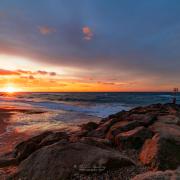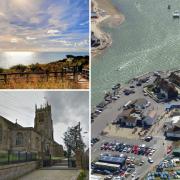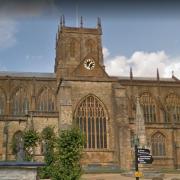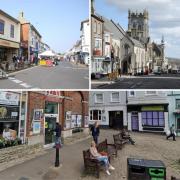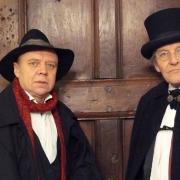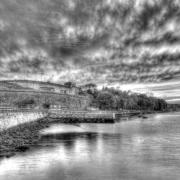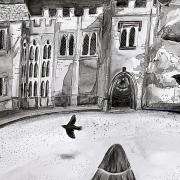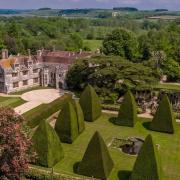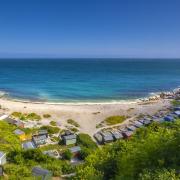Take a leisurely stroll through Bridport Town’s fascinating history

Bridport’s first charter was granted by Henry III in 1253, and re-affirmed by Elizabeth I for supplying ropes and sails for her navy, especially with the 1588 Armada threat. Bridport has been famous for rope and net-making since the 13th century, and lots of Bridport’s older houses have exceptionally long and narrow burgage plots, or spinning walks, where out-workers trudged back and forth twisting the yarn and twine as they walked.
Bridport supported Parliament during the Civil War and Lieutenant Lea was garrisoned here from June 1643. Charles I was executed in 1649 and when his 21-year-ld son, the future Charles II was defeated at Worcester in 1651, he tried to escape to France from Lyme. Having been discovered there, he fled through Bridport, changing course to Broadwindsor before finally embarking from Shoreham in West Sussex.

The Walk
1 Bridport Town Hall was built 1786 with Council Chamber above and market stalls beneath. The cupola and clock were added in 1804. Cross at traffic-lights and walk down West Street B3162. On right Victoria Grove corner, the three-storey stone building is part of Gundry’s Court Mills which produced cordage and netting since 1665. Past here, the brick building with the sack hoist is West Mill. After left Tannery Road entrance to the car park, and over the River Brit bridge, turn right into North Allington. Cross St Swithin’s Road and visit St Swithun’s Church on your left. Built in neo-Grecian style in 1827, this attractive building was renovated in 1901.

2 Return to the T-junction with Balson’s opposite, England’s oldest family butchers established in 1515. John Balson had a stall in South Street in Henry VIII’s time. Turn left, cross and pass the White Lion. Cross Tannery Road. Past West Mill again, turn right into unsigned St Michael’s Lane by the Cornish Pasty shop. Meeting Tannery Road again, keep straight on. At the Hope and Anchor, turn left into Rope Walks. With the car park right, see the left long narrow burgage rope-walk plots behind West Street’s houses. At the car park’s end, turn right, still Rope Walks. Continue past Stephen Whetham’s huge warehouse to Gundry Lane. Turn left.
3 Past the Local History Centre and Whetham’s coach house, go through the left gate into Borough Gardens with Stephen Whetham’s, proprietor of Priory Mills, house and garden. Continue up Gundry Lane into South Street. Turn left to Buckydoo Square, probably from ‘Buck and Doe’ for the public toilets opened 1880 for men and 1912 for women, and the Arts Centre, built as the Wesleyan Church in 1838. Then turn around and walk down South Street. Pass left Bridport Museum. The castle on Bridport’s shield figures a Saxon castle, probably on the site of this mid-16th century museum, once the ‘Castle Inn’. Alternatively, it may have been further down South Street behind the Chantry.

4 After the Electric Palace which opened in 1926, continue to right early-13th century St Mary’s Church. The transepts are original and the tower is 14th century. Opposite is the Friends (Quakers) meeting house dating from 15th-16th century. Continue to the 14th or 15th-century Chantry on South Walk corner. Its purpose is uncertain. Concerning Bridport’s ‘castle’, the cottages after the Chantry are signed ‘Castle Square’. Over the River Asker bridge, cross at the traffic lights to see Palmers Brewery thatched buildings in West Bay Road. Walk along Skilling Hill Road to see the waterwheel. The brewery, founded in 1794, is the only thatched brewery in Europe and the 1879 waterwheel is the oldest in the South-West.
5 Returning to the traffic lights, cross to the supermarket side. After the petrol station, 50 yards back up South Street, take the cycle-path alongside the river. At a paths’ crossing with a left footbridge, turn right to the A35 half-gate. Cross carefully into Pasture Way. Up to Crock Lane T-junction, turn left. Enjoy an elevated half-mile stroll passing attractive houses with good views over Bridport. On a left bend, take the right unsigned lane. It’s Lower Walditch Lane. At the mini-roundabout, the right lane leads to The Hyde. Joseph Gundry’s Victorian Gothic 1883 country house.
However, keep straight on, with Jellyfields Local Nature Reserve right and Manor Fields bungalows left.
6 Reaching Bridport Cemetery, go through the gates. Follow the main path up and over, between two chapels and down to East Road A35 gate. Cross carefully and turn right up the pavement. At the top, turn left into Lee Lane. The 1901 marker stone commemorates where Charles II’s escape route changed course 250 years earlier. Past King Charles Way, continue up the lane. Take next left Jessop Avenue with fine views over Bridport. Descending, take the right cul-de-sac. At the end, go through the footpath-gate into a high field. Follow the path straight down to the footpath half-gate and River Asker footbridge. Over, cross the lesser paths and meadow to the Tarmac path. Turn left. Follow the path above the meadows. Emerge into Sea Road North A3066 beyond Co-Op’s car park.
7 Over the crossing, go left for 20 yards. Take the right Tarmac path along the King Charles Tavern wall into St Andrew’s Road. Turn left. In half a mile, after left 1860 St Andrew’s Church, continue to Barrack Street. On the sharp-right corner, the 1795 Barracks were built to house troops due to the threat of a Napoleonic invasion, and became the Union Workhouse in 1834. Keep straight on, passing right 1886 Liberal Hall where the first Electric Palace cinema opened in 1912. Reaching East Street, turn right and go straight on. Pass the right Literary and Scientific Institute which opened in 1830 briefly as Mechanics’ Institute, then re-opened 1854 as a reading room and local museum and is now is a local meeting hub and workspace with a café (lsibridport.co.uk). It was Bridport Library until 1998.
8 Next door, the ‘Chapel in the Garden’ Unitarian Chapel opened in 1794. Opposite is the 1593 Bull Inn where Lieutenant Laponetiere changed horses on his journey from Falmouth to London with news of England’s victory at the Battle of Trafalgar in 1805. During the 1685 Monmouth’s Rebellion, here and at East Street bridge, the Dorset militia faced the Duke of Monmouth’s army and forced them to retreat to Lyme. Opposite the Town Hall is the black-and-white old George Inn with its bow windows, where Charles II stopped to eat on his flight from Lyme. Now you’re back where you started.




